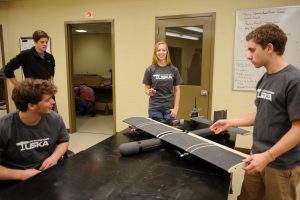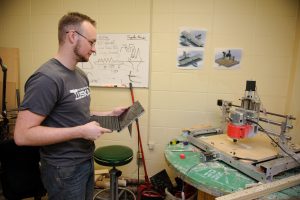
Jamie Moon, a junior in mechanical engineering, display the unmanned aerial vehicle he and other students designed and continue to build as part of TuskaUAV.
A team of University of Alabama students is proving that drones are no longer just for the military.
Because they are small and can be flown autonomously, drones, also known as unmanned aerial vehicles, are an inexpensive way to conduct aerial surveillance. In recent years they have proved to be useful in various fields like agriculture, police work and emergency response. As drones become more viable, universities are finding ways to incorporate drone research in engineering curricula. At UA, Dylan Quick, from Trussville, Alabama, took notice of the trend and decided it was time to bring a UAV team to campus.
Although he is a senior in mechanical engineering, Quick said he has always had an interest in airplanes. His interest in building a UAV began as a hobby. Eventually he found some friends who shared his interest and together they formed a team called Tuska UAV.
“This is what I really wanted to do,” he said. “We didn’t have [a UAV team,] so I started one.”
Of course, the process of starting Tuska UAV was not quite that simple. For starters, the team’s members had no idea what they wanted to do with the drone once it was finished. Unlike most student engineering teams that operate on campus, Tuska UAV is not affiliated with a senior design project or a national competition.

From the beginning, the team has struggled to find a student design competition for UAVs. After giving it some thought, the team’s members decided they would continue to build the vehicle and decide on a competition later. The students hope to join the Society of Automotive Engineer’s Aero Design Series contest eventually, Quick said.
“We wanted to have the camera set up on the plane and we wanted to put it in auto-pilot, but many of the competitions don’t allow that and the other competitions that did were too far away or too expensive for us to join,” Quick said. “In the future we’d love to participate in the SAE aero competition, but we want to get our first vehicle finished before we go forward.”
The team now consists of about 20 members. Together, they built their own tools and equipment using Quick’s apartment as a workspace in the spring of 2014. Quick spent about six months building a Computer Numerical Control router that would cut and carve pieces for the plane he designed using CAD software on his computer. The next year, the team was able to find a faculty advisor, Dr. Eben Broadbent, assistant professor of geography at the University, who provided the students with a work space in Biology Hall.
“Currently, [the team] is a way to learn and get familiar with the systems,” said Kara Parks, a junior in mechanical engineering from Maryland who heads Tuska UAV’s airframe team. “All of us have learned a lot about manufacturing and aerodynamics. It’s a way to use what we’ve learned in class.”
After designing their UAV, the students divided into sub-teams. The airframe team was tasked with designing the structure of the UAV, the manufacturing team cut and built the materials for the plane, the avionics and surveillance team handled the vehicle’s electronics and its radio system and the resources support team searched for sponsorship opportunities.
Now that the vehicle is nearly finished, the team just has to figure out what to do with it. After watching a video about the EF4 tornado that struck Tuscaloosa in 2011, Jamie Moon, a junior in mechanical engineering from Arlington, Tennessee, who serves as vice president of the team, realized that their vehicle could potentially be useful for emergency responders.

It can be difficult for first responders to maneuver around debris left by a natural disaster. Helicopters are an option in such cases, but the noise they cause can be a hindrance for finding survivors. The team hopes their vehicle might be a helpful alternative. Once the initial plane is finished, team members plan to continue producing more planes they could potentially send to police departments and other emergency organizations. Until then, Quick said, the team has a lot more work to do.
“I think it’d be a good idea to take a step back and review [the vehicle] after we’ve flown it, see what we did wrong and what we can do better next time.” Quick said.
Although he will be graduating in December, the team members plan to continue forward. Moon will take his place as president and continue working with Parks and the team’s underclassmen who have actively participated in the construction of their first UAV. Parks predicts that, with the help of an additional adviser, they could begin preparing a concept design to enter the SAE Aero Design competition in 2017.
“For the continuance of the club, I think it would be helpful to bring in an additional adviser,” Parks said. “The competition we’re looking at also has the idea for using [the drone] for humanitarian purposes and disaster relief, so it aligns well with what we already do. We want to use our planes and use our engineering skills to help people.”